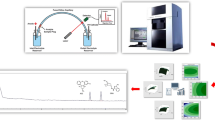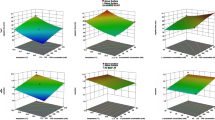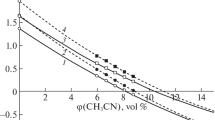Abstract
Development of effective chromatographic or electrophoretic separation involves judicious deciding of selection of optimal experimental conditions that can provide an adequate resolution at a reasonable run time for the separation of interested components. Box-Behnken factorial design was effectively applied for the separation optimization of eight structurally related sulfonamides using capillary zone electrophorosis and reverse high performance liquid chromatography. Optimum values for volume ratio of THF to H2O in eluent, column temperature and flow rate of eluent are found as 12 to 88, 35 °C and 1.0 mL/min, respectively. Box-Behnken modified optimization model is extended to separation by capillary electrophoresis (CE). While using CE, a satisfactory separation is achieved with a minimum resolution larger than 1.0 for a separation time less than 10 min.
Similar content being viewed by others
References
ZHANG Y P, LEE K P, KIM S H, et al. Comparative study on the chiral separation of phenyl alcohols by capillary electrophoresis and liquid chromatography[J]. Electrophoresis, 2004, 25: 2711–2719.
RAGONESE R, MACKA M, HUGHES J, PETOCZ P. The use of the Box-Behnken experimental design in the optimisation and robustness testing of a capillary electrophoresis method for the analysis of ethambutol hydrochloride in a pharmaceutical formulation[J]. J Phar Bio Anal, 2002, 27: 995–1007.
CORSTJENS H, BILLIET H A H, FRANK J, et al. Optimisation of selectivity in capillary electrophoresis with emphasis on micellar electrokinetic capillary chromatography[J]. J Chromatogr A, 1995, 715: 1–11.
HOWS M E P, PERRETT D, KAY D J. Optimisation of a simultaneous separation of sulphonamides, dihydrofolate reductase inhibitors and β-lactam antibiotics by capillary electrophoresis[J]. J Chromatograph A, 1997, 768: 97–105.
HARANG V, TYSK M, WESTERLUND D, et al. A statistical experimental design to study factors affecting enantioseparation of propranolol by capillary electrophoresis with cellobiohydrolase (Cel7A) as chiral selector[J]. Electrophoresis, 2002, 23: 2306–2319.
ZHANG Y P, ZHANG Y J, GONG W J, et al. Rapid separation of Sudan dyes by reverse high performance liquid chromatography through statistically designed experiments[J]. J Chromatogra A, 2005, 1098: 183–187.
AKESOLO U, GONZALEZ L, JIMENEZ R M, et al. Multivariate optimisation of a cyclodextrin-assisted-capillary zone electrophoretic method for the separation of torasemide and its metabolites[J]. J Chromatogra A, 2003, 990: 271–279.
FUH M RS S, CHU S Y. Quantitative determination of sulfonamide in meat by solid-phase extraction and capillary electrophoresis[J]. Anal Chim Acta, 2003, 499: 215–219.
JALALI-HERAVI M, GARLANI-NNEJAD Z. Prediction of electrophoretic mobilities of sulfonamides in capillary zone electrophoresis using artificial neural networks[J]. J Chromatogr A, 2001, 927, 211–218.
LIN C E, Lin W C, CHEN Y C, et al. Migration behavior and selectivity of sulfonamides in capillary electrophoresis[J]. J Chromatogr A, 1997, 792: 37–47.
LIN C E, CHANG C C, LIN W C. Migration behavior and separation of sulfonamides in capillary zone electrophoresis II. Positively charged species at low pH[J]. J Chromatogr A, 1997, 579: 203–209.
Author information
Authors and Affiliations
Corresponding author
Additional information
Foudnation item: Project(20235010) support by the NSFC-KOSEF Scientific Cooperation Program; Project supported by the Program for New Century Talents of University in Henan Province; Program for Backbone Teacher in Henan Province, China
Rights and permissions
About this article
Cite this article
Gong, Wj., Zhang, Yp., Zhang, YJ. et al. Optimization strategies for separation of sulfadiazines using Box-Behnken design by liquid chromatography and capillary electrophoresis. J Cent. South Univ. Technol. 14, 196–201 (2007). https://doi.org/10.1007/s11771-007-0039-7
Received:
Accepted:
Published:
Issue Date:
DOI: https://doi.org/10.1007/s11771-007-0039-7




